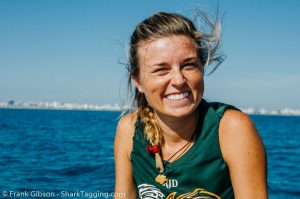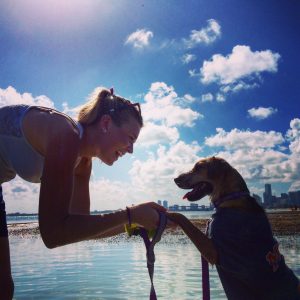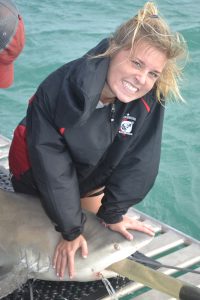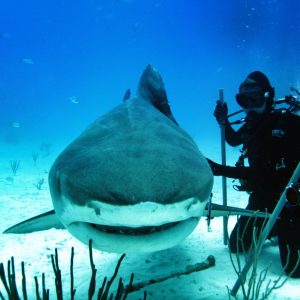Meet Our Team: Emily Rose Nelson
1. What’s your role in the lab?
Hey guys, I’m Emily! I’ve been working with the Shark Research Team at the University of Miami for about 4 years now. During my time with the RJ Dunlap program I have been involved with a number of projects. I have been the shark satellite tracking coordinator since 2013. I am responsible for keeping track of all our satellite tagged sharks. Nightly, I receive emails that indicate which of our sharks have transmitted throughout the day. Using a number of different databases I can then examine the location and movement of animals. From here, the tracks are updated on our website so the public can view the animal’s movement in near real time. The information we receive from these tags is used for numerous research projects going on in the lab to further enhance shark conservation. My current research involves looking at the movement patterns of tiger sharks and comparing it to a number of different morphological variables. In particular, we are trying to determine what exactly (i.e. tail size, body condition, reproductive status) determines how far, how fast, and where an individual will move.
2. Tell us a little about yourself.
I received my Bachelor of Science Degree in Marine and Atmospheric Science at the University of Miami, Rosenstiel School of Marine and Atmospheric Science in 2014 and will be starting work towards my Masters of Science in Marine Affairs and Policy with Dr. Hammerschlag in Fall 2015. Outside of the lab, I can probably be found tutoring (I love working with kids) or playing with my dogs and cats. I love avocados, water skiing, concerts, Blackhawks hockey, and driving across the Rickenbacker Causeway.
3. How did you get interested in marine biology and conservation?
For as long as I can remember I have wanted to spend my life working with the ocean and the amazing creatures within it, forcing me out of my land-locked home town of Chicago.
4. What’s your favorite part about working in the lab?
Working with the shark team at RSMAS has been one of the best experiences of my life. The adrenaline rush that comes after successfully completing a work up on a 350 centimeter tiger shark in the Bahamas is indescribable. Running statistical tests on a new set of data and finding a significant result is super exciting. However, the best part about being a member of this lab is the team I am surrounded by. It is an honor to work alongside some of the most talented and passionate people in the field. I am lucky to be able to learn something new from my colleagues every day and even luckier to call them some of my best friends.




